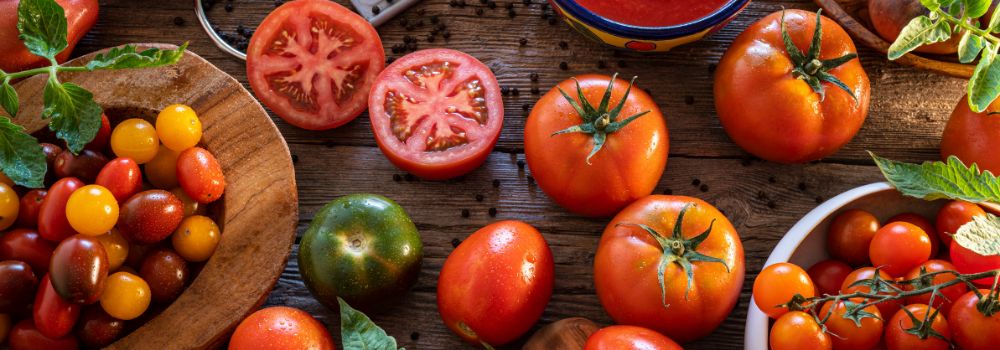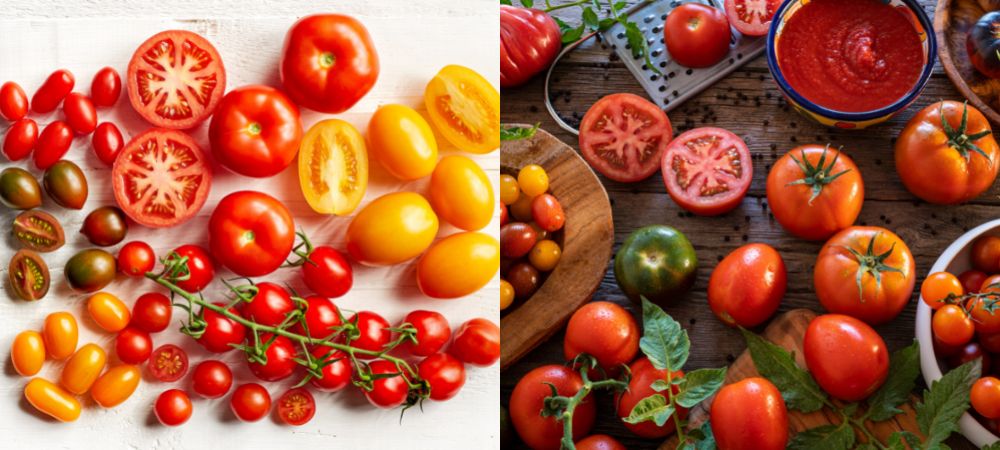How to Grow Tomatoes

Tomatoes are the most popular choice of home grown produce and with many varieties available there is always something new to try for gardeners of all experience levels. Why not start some in your garden to grow during Spring and Summer? You will be enjoying the delicious fruits in no time at all.
How to grow Tomatoes from seed
You can start your tomato seeds early by sowing them indoors in Jiffy® Peat Pots or Pellets, or in seed raising trays, from as early as July. A Jiffy® Windowsill Greenhouse will also provide a perfect seed raising environment on a sunny windowsill.
Cover the seeds lightly with fine soil and water gently so they are not disturbed. To aid germination, keep the pots or trays at approx. 15-20°C by placing it on top of a HeatPad, and cover with polythene or a propagator lid to help keep the compost moist and warm. Remove the cover when seedlings appear. Alternatively, tomato seeds can be sown direct into a garden bed or container as soon as the risk of frost has passed and the soil is sufficiently warm day and night.
If your tomatoes are kept in their pots for some time before transplanting ensure you feed them regularly with a balanced liquid vegetable feed, about every week or so. Tomatoes are hungry crops and will use up the nutrition inside a small pot of soil quickly.
How to care for your Tomato plants
Transplant the seedlings into the garden when they are large enough to handle, and when danger of frost has passed – usually before the end of September. Always hold seedlings by a leaf to avoid crushing the stem. If you have grown your tomatoes in Jiffy® Peat Pots or Pellets, you can transplant the seedling with pot and all, thus avoiding transplantation shock.
Before transplanting young plants, acclimatise them to outside conditions by placing in a sheltered location for a few hours during the day, gradually increasing the time over a two week period. Once ‘’hardened off’’ plant them into their final growing position at the spacing indicated on the packet.
Mulch the ground around the plants once the soil has fully warmed up. This will help to conserve moisture and suppress weeds. Feed the plants every 4-6 weeks with organic slow release fertiliser, such as a pelletised poultry manure amended with trace elements. It is also helpful to apply a high potassium liquid fertiliser and seaweed solution fortnightly when the flowers start to form fruit.
Tall growing varieties that are indeterminate will need support, either with canes or string tied to an overhead A frame. Bushy or determinate varieties can often sprawl onto the ground though if you live in a humid or wet environment they will also benefit from staking, to allow more airflow in and around the plants to help with preventing disease.
Your tomatoes side shoots also need pinching out regularly to contain the plants. These appear between a leaf node and the main stem, just below the flower stem. Work through your plant every week or two during the height of the growing season to remove these side shoots, allowing around 2-3 main stems to grow and mature depending on the size of your frame or trellis. If using a single stake or string it is best to remove all of the side shoots so you only have a single branching plant.
When your plant reaches the top of your stake or trellis remove the growing tip of the plant to bush out. If it grows too tall above the support it will slump over and break. Alternatively use the ‘’lower and lean’’ method, this is great for those trailing types. The string on your frame is lowered, allowing the new growth up top to reclimb the twine leaving a long stem along the ground. The bottom of the stem is removed of all old leaves to keep the crop healthy and allow plant growth to refocus into the fruits and new leaves.
The physical characteristics of the fruits are categorised in various ways
‘Cherry’ tomatoes are small, generally round fruits which typically have a wonderfully sweet flavour – great for simple snacks and salads or roasting.
‘Standard’ tomatoes are somewhat larger, medium sized fruits, often beautifully aromatic with a well-balanced acid-sweet flavour – perfect for salads, sandwiches and sauces.
‘Beefsteak’ tomatoes are the largest type with meaty flesh that usually has a more mellow flavour. Perfect for cooking and slicing for burgers or sandwiches.
Other categories include ‘Plum/Egg’ tomatoes, a traditional cooking type that is often used for Italian sauces and comes in various sizes, and ‘Grape’ tomatoes that bear very sweet, slightly smaller and more elongated fruits than a cherry tomato.
Hints and Tips
- Water plants regularly to prevent the skins from splitting. It is best to water at soil level, keeping the foliage of the plants dry to discourage mildews.
- When transplanting young tomato plants, bury them deeper than their original position. The level of the compost can come almost up to the first set of leaves. The stems will then develop new roots helping to secure and feed the growing plants.
- If you are staking the plants, do it immediately after transplanting to minimise the risk of damaging new roots.
- Remove lower leaves as they discolour or die off to prevent disease. They are best put into the bin rather than composted.
- Use surplus fruit to make chutney or freeze as sauces, tomato juice or as whole fruit.
- Mixing tomato plants with French marigolds may help to deter pests such as whitefly. Other good companion plants are basil, chives, onions and nasturtiums.
FAQs
Why are my tomatoes not ripening/fruiting?
Tomatoes will ripen best in warm sunny weather. If it is too cold or even too hot it can set back the growth on your plants as they become stressed. To encourage them to ripen faster prune off the lower leaves around the truss and remove side shoots on your plant to direct the crops energy into ripening fruits.
If your tomato vines are not producting flowers or fruit, this usually means they are lacking in potassium, fertilise regularly with a high potassium liquid fertiliser to encourage flower and fruit growth.
Why are my tomatoes wilting?
Tomatoes can wilt in warm weather after transplanting or if they have dried out. Use a seaweed solution in these instances and a soil wetting agent if required. Generously water around the rootzone or set up a drip line that will keep the plants well-watered. Other reasons for wilting tomato plants can be fungal issues such as Verticillium Wilt and Fusarium Wilt. If these fungal diseases are common in your region, choose resistant varieties and ensure you rotate your crops each year.
What is the difference between an indeterminate and determinate tomato?
Indeterminate tomatoes are trailing/climbing types, new fruit will set along smaller stalks off the main stem as it grows taller and taller. They will continue to grow and fruit all throughout the spring and summer provided you keep the plant healthy and can train it across or up a trellis.
Determinate tomatoes are usually bushier/shorter and stop growing after flowering, therefore they set their fruit in a shorter period of time with the bulk of them ripening in one go. Bushy determinates may sometimes grow along the ground however we recommend staking your tomatoes for better airflow.
Some varieties that are harder to classify may fall into semi-determinate categories if they have characteristics of either type.
How long do tomatoes fruit for?
Trailing indeterminate tomatoes may fruit for many months provided they are well fed and maintained. Determinate bushy tomatoes may set the majority of their fruits in just a few weeks.
How do tomatoes pollinate?
Tomatoes have flowers that are described as ‘’self-fertile’’, the one flower contains all the necessary components to successfully pollinate. They do not have separate female and male flowers much like pumpkins for example do. This means they pollinate very easily when there is wind, water and insects present. If growing tomatoes indoors use a pollinator brush or stick to release the pollen and ensure successful pollination.
Mr Fothergill's stocks a huge range of tomato seeds ranging from your common supermarket types to more unique and exotic varieties not commonly seen in Australia - view our extensive range of tomato seeds and kits here.



